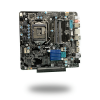Hi folks, it's been a while since I did a custom build. The last one was about 2015, putting a NUC-style Gigabyte Brix Pro 4700R into an Akasa Euler case left over from a previous build. It's time for an update, which will be used for general purpose computing with some light gaming (flight simulators). As it will be going in my home office, I'm optimizing for silence as well as something that doesn't heat up the room at idle but can burst to higher performance for the occasional heavy workload.
Total power budget is 65W for the CPU + 75W for the GPU, run from an external 192W AC-DC power adapter.
I recently came across some nice custom cases made by FanlessGuy, who has a youtube channel showcasing his work. What appeals to me is the stylish efficiency of building a "case" around a big giant heatsink. Unfortunately, I don't have a lot of free time, so this will be a slow process (about 2 months and counting so far), but I will post updates when I can.
Parts List

Preview of the materials I plan to use. Bamboo ply is leftover cutoff from a counter install.

First set of blocks in 1-1/4 and 1 inch aluminum to allow extra space for other devices - have since decided to go to 3/4 and 1/2 inch instead to make the total assembly thinner

Test fit of heatsink blocks - will need a thin shim under the CPU block to even things out:

Total power budget is 65W for the CPU + 75W for the GPU, run from an external 192W AC-DC power adapter.
I recently came across some nice custom cases made by FanlessGuy, who has a youtube channel showcasing his work. What appeals to me is the stylish efficiency of building a "case" around a big giant heatsink. Unfortunately, I don't have a lot of free time, so this will be a slow process (about 2 months and counting so far), but I will post updates when I can.
Parts List
- Microstep TH310C-P motherboard - this is a nice ITX board with a side-mounted PCIe slot, only available direct from China as far as I can tell
- MSI GEFORCE GTX 1850 D6 AERO ITX OC - new GDDR6 version of the 1650 with a 75W TDP (no external power required)
- i7-9700F CPU
- Samsung (MZ-V7S1T0B/AM) 970 EVO Plus SSD 1TB
- HyperX Impact 32GB 2666MHz DDR4 CL16 SODIMM Laptop Memory HX426S16IB/32
- 12V 192W AC-DC power supply from mini-box.com (makers of the Pico PSU)
- Heatsink HS Marston 96CN-02500-A-200 300x250x40mm or Heatsink USA equivalent
- Inventables white corian 1/4 inch x 8 inch x 12 inch
- 1/2 and 3/4 aluminum plate for CPU and GPU heatsink adapters
- various other aluminum angle and fasteners

Preview of the materials I plan to use. Bamboo ply is leftover cutoff from a counter install.

First set of blocks in 1-1/4 and 1 inch aluminum to allow extra space for other devices - have since decided to go to 3/4 and 1/2 inch instead to make the total assembly thinner

Test fit of heatsink blocks - will need a thin shim under the CPU block to even things out:













